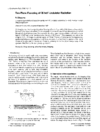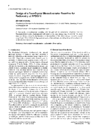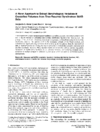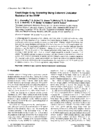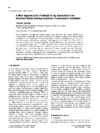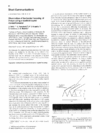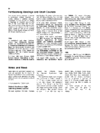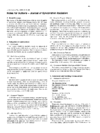issue contents
January 1998 issue

Cover illustration: Aerogel speckle pattern produced by illuminating a disordered aerogel sample by a nominally coherent X-ray beam at wiggler beamline X25 at the National Synchrotron Light Source, see Tsui, Mochrie and Berman, pages 30-36.
facility information
research papers
An experimental and theoretical investigation is made of a two-plane focusing refractive lens using undulator radiation in the hard X-ray range.
The beamline will provide radiation with tunable photon energies from 1.75 keV to 10 keV and high spectral purity for radiometric calibrations and other applications.
A soft X-ray beamline with a variably polarizing undulator has been designed at SPring-8 to be used for photoemission spectroscopy, focusing on actinide compounds as well as unsealed radioactive materials.
The use of an X-ray waveguide for scattering and diffraction experiments at an ESRF undulator is discussed. A maximum flux of 8 × 109photons s−1 at λ = 0.083nm was obtained with a multilayer monochromator. The combination of an Si (111) monochromator and ellipsoidal mirror resulted in a flux of 1 × 109photons s−1 in a 0.15 × 30 μm2 beam.
A novel approach has been developed to analyze time- resolved SAXS data using correlation function and interface distribution function methods. It has been demonstrated that detailed time-dependent morphological variables can be extracted from PET crystallization using this approach.
Measurements, carried out at beamline X25 at the National Synchrotron Light Source, of X-ray speckle produced by an aerogel sample are presented. A statistical analysis of the speckle intensity is performed and compared with what may be expected based on the X25 source dimensions and the optics employed.
A high-coherent-flux X-ray beam for small-angle-scattering studies has been produced and analyzed at the Troïka beamline of the European Synchrotron Radiation Facility. The statistics of a static speckle pattern are used to characterize the coherence properties.
A new apparatus for polarized X-ray absorption fine structure (XAFS) at low temperature and its applications to local structure studies of high- Tc superconductors and optically excited states, using `pump and probe' XAFS, are described.
A new kind of horizontal focusing of X-rays was observed using a toothed-crystal monochromator. The focusing may be attributed to the properties of inclined diffraction.
A biomedical application of synchrotron radiation comprising X-ray fluorescence imaging and histochemical staining was employed to examine the detailed distribution of metal elements and morphological changes in the kidney section of mercury-treated rats. The spatial resolution was improved to 5 × 5 μm2.
notes and news
Free 

international union of crystallography
Free 



 journal menu
journal menu

















